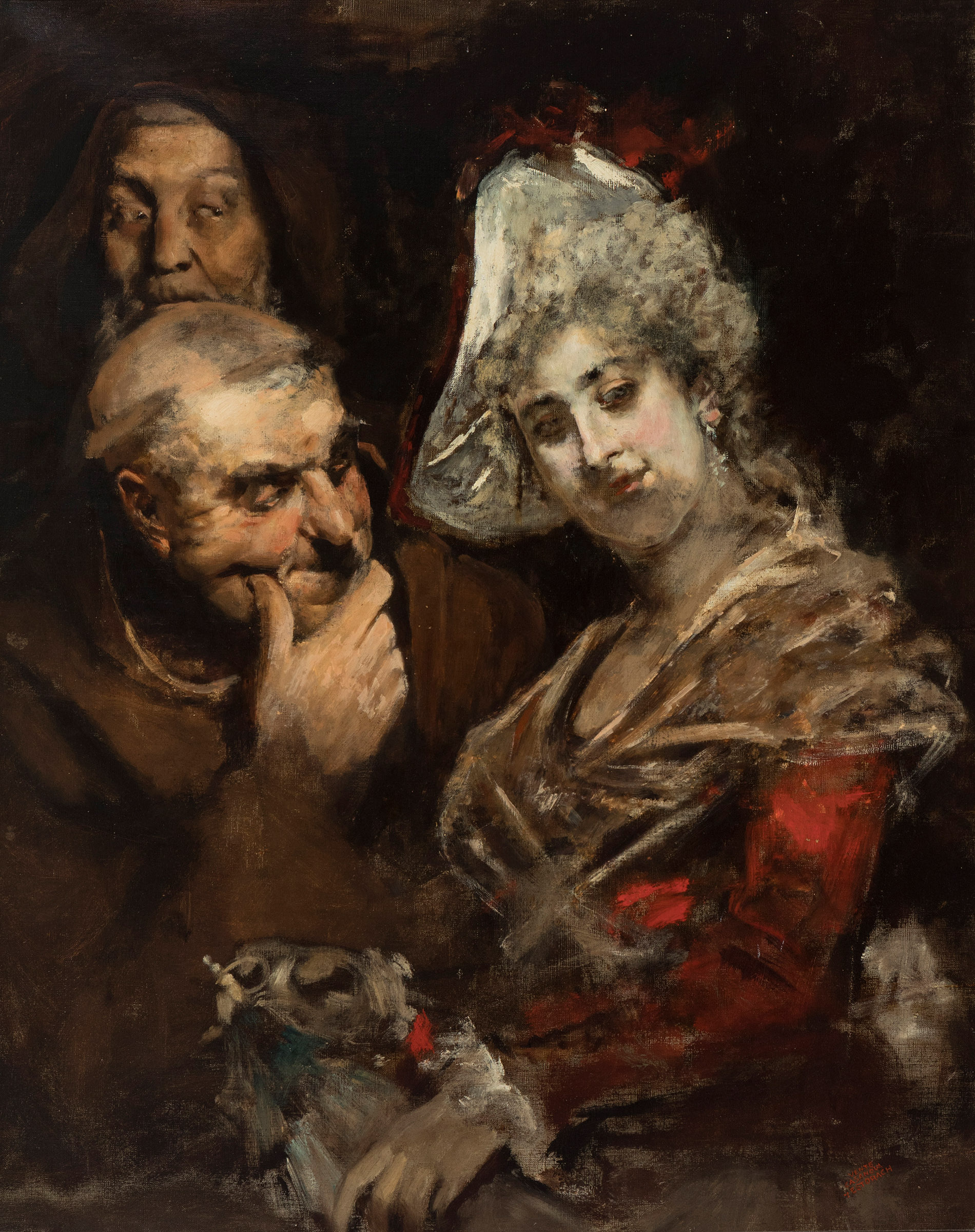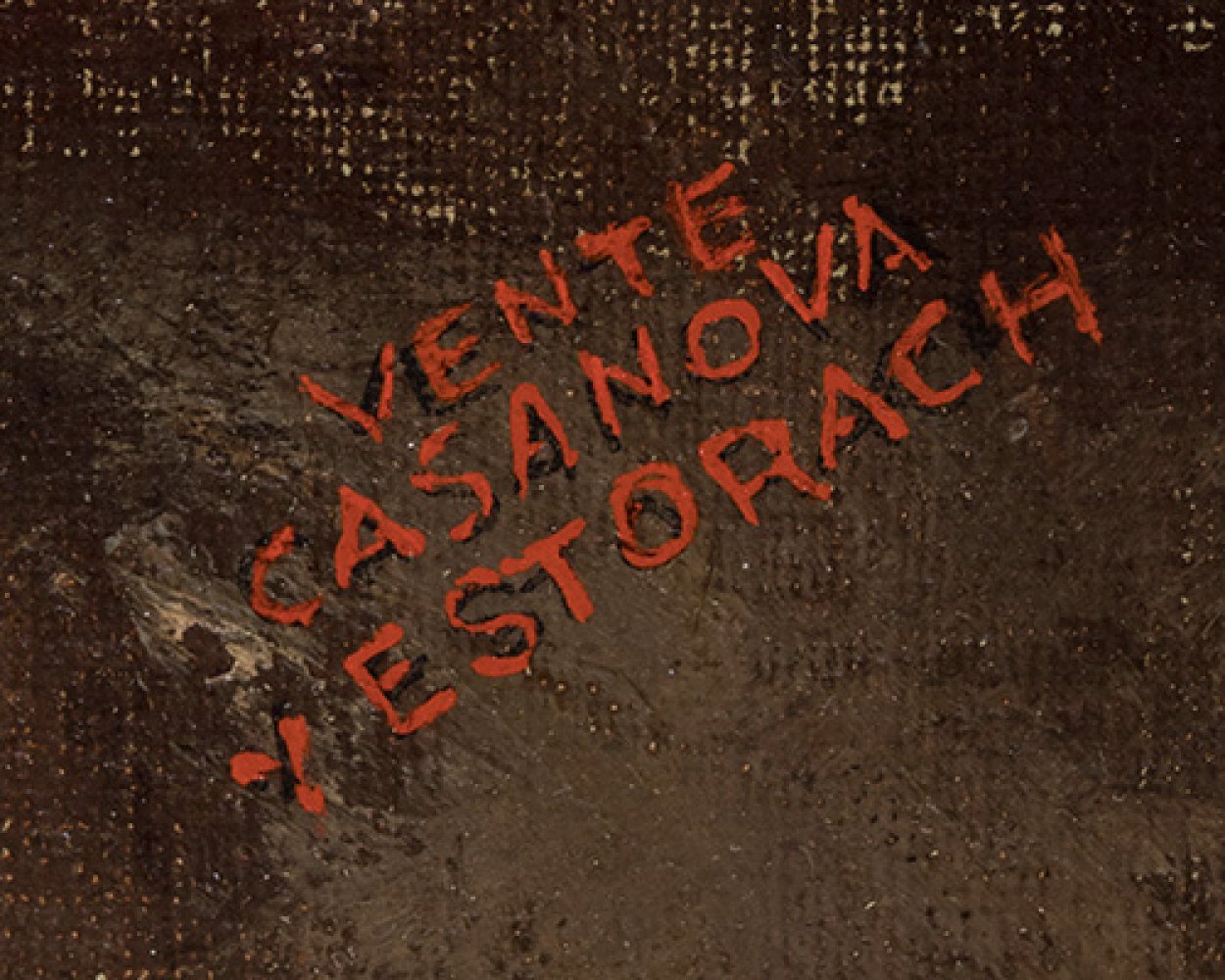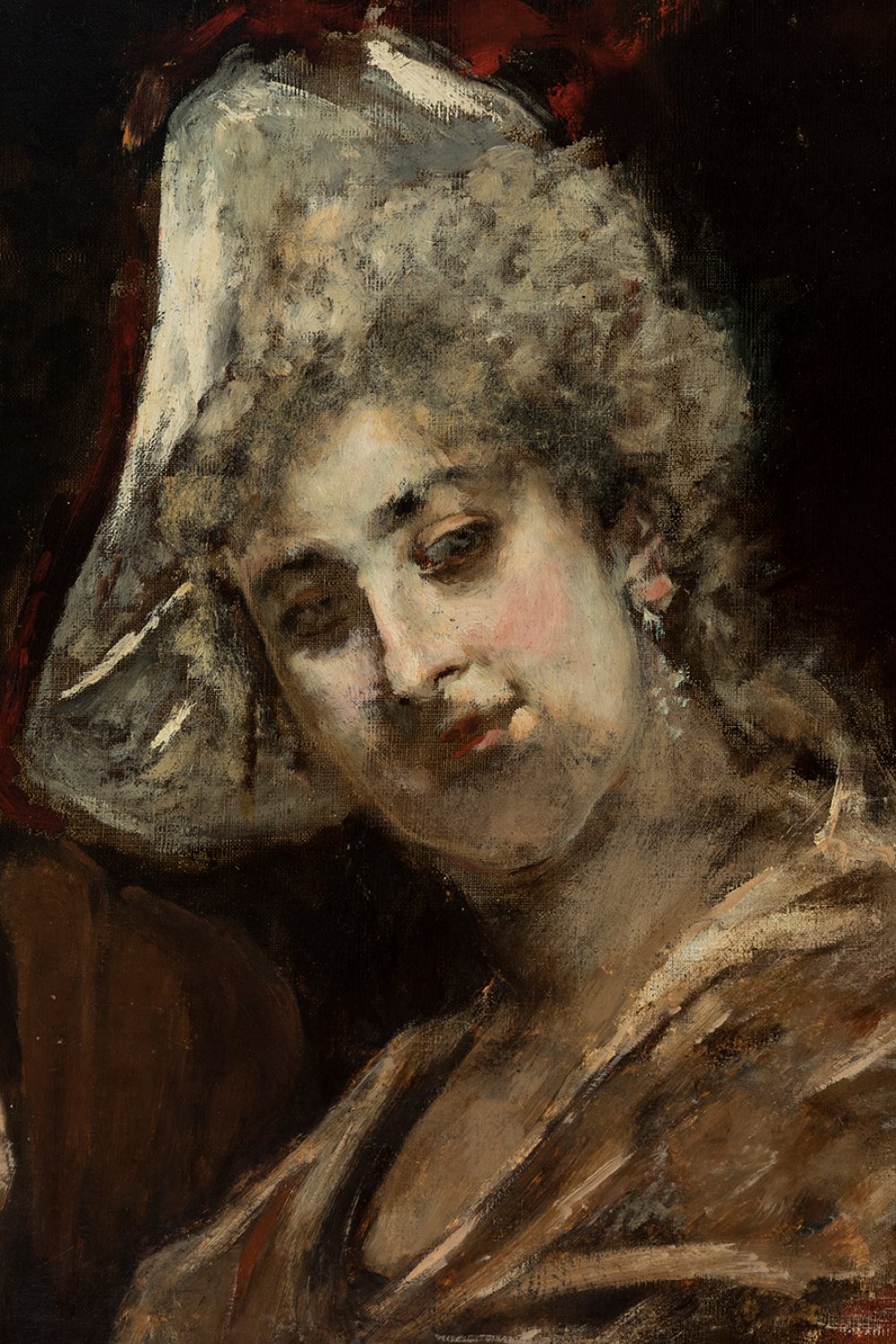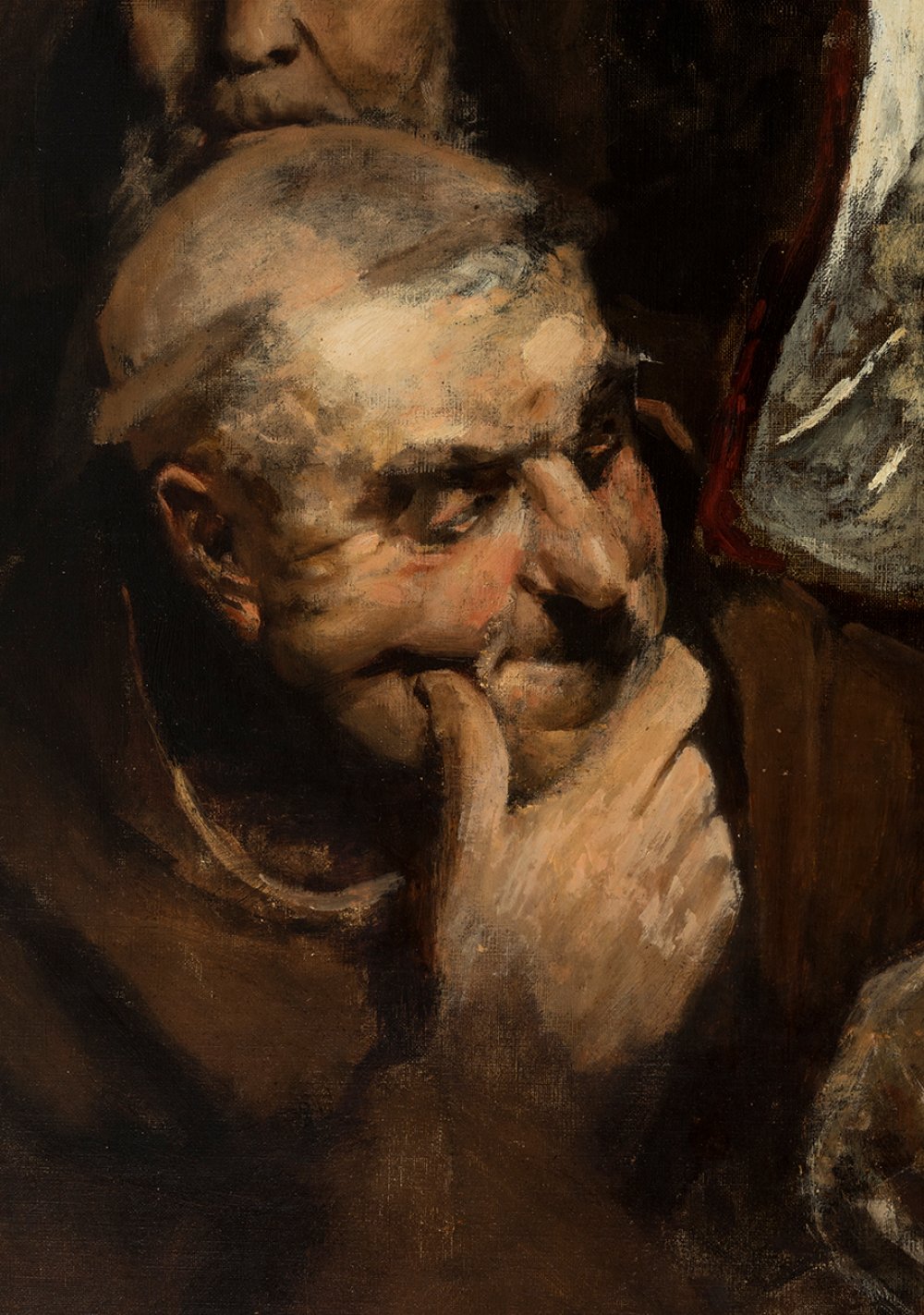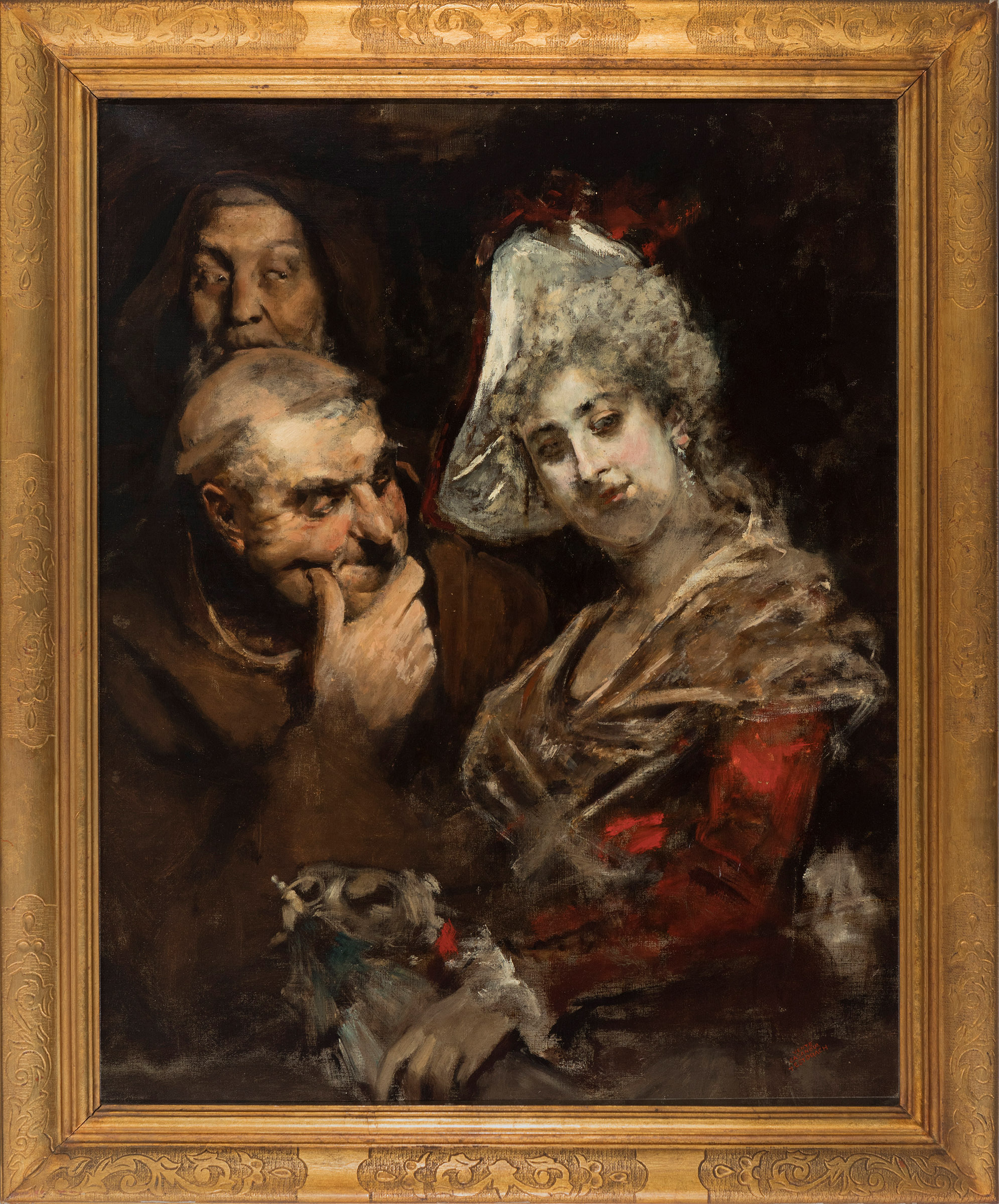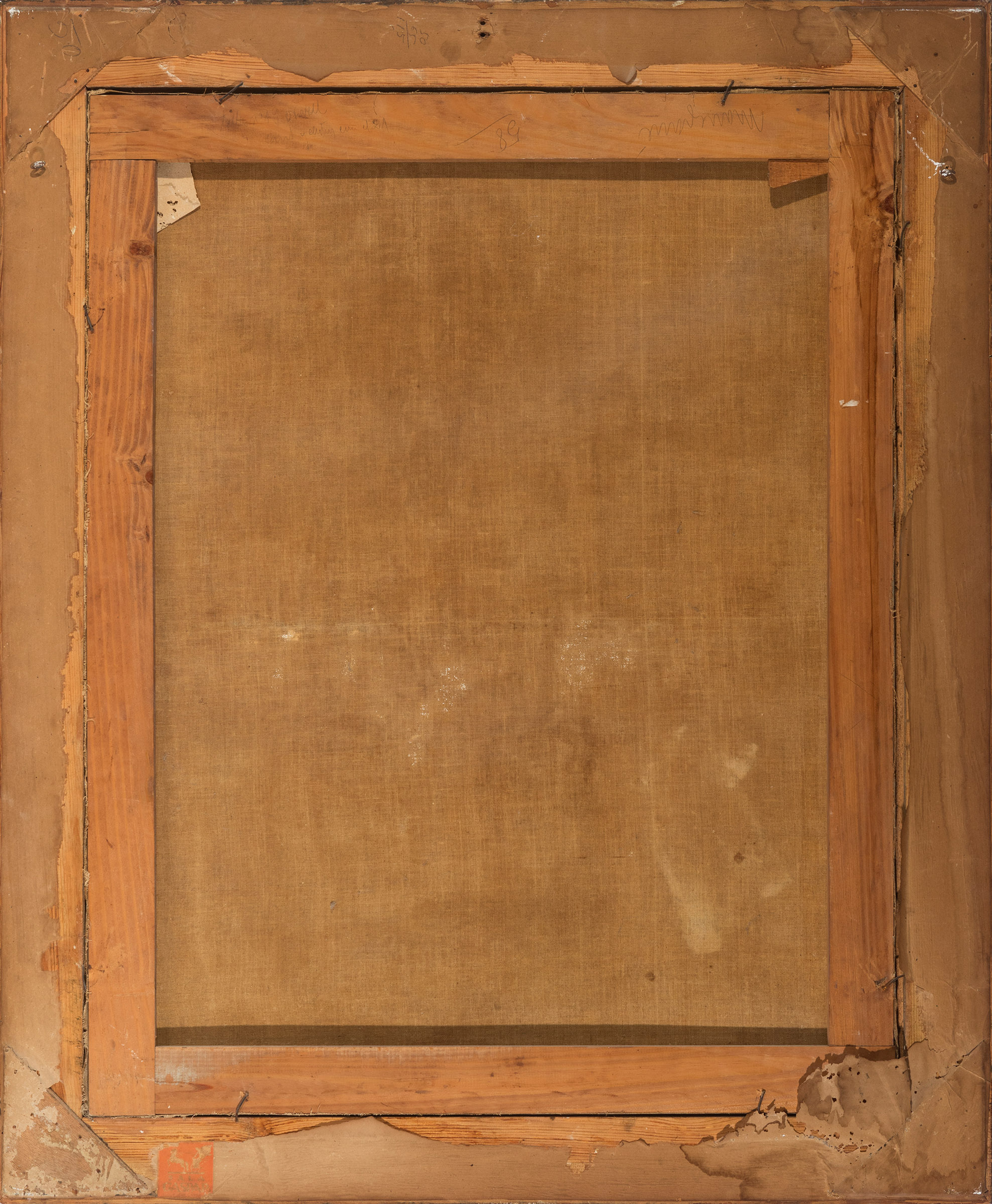4
ANTONIO CASANOVA Y ESTORACH (Tortosa, Tarragona, 1847 - Paris, 1896)."Temptation".Oil on canvas.
"Temptation".
Oil on canvas.
Signed in the lower right corner.
Label of the Sala Gaspar, Barcelona, on the back.
Work verified by Aleix Roig, expert in the work of Casanova and Estorach.
Good state of preservation. Frame with some damage.
Measurements: 92 x 72 cm; 107 x 89 cm (frame).
In this canvas, we can clearly appreciate the preciosist style that Casanova and Estorach cultivated. Underneath the swift and rapid brushstrokes with broken touches that give the image an intuitive and spontaneous aspect, there is a patient and polished work, based on superimposed layers, thanks to which the expressions seem to come to life. See here the two friars, the priceless mischievousness of their mimicry: one looks sideways, almost squinting, at the young girl; the other, with his lips tight and his hand around his chin as if he were meditating, also seems to be ogling the woman, who for her part does not notice anything, or pretends not to notice. Because, in the end, everything is a game of simulations in this brilliant painting, splendid in theme and technique. In fact, the scenes of monks, cardinals and other ecclesiastics, enjoying a comfortable life or delighting in the contemplation of the other sex, were this painter's favourites. Casanova i Estorach drew formally on Baroque sources, particularly the naturalism of the portraits of Velázquez, Frans Hals and Rembrandt.
A painter of Romantic genre painting, Antonio Casanova i Estorach began his training in the studio of José Planella and at the La Lonja School in Barcelona. At the latter he was a pupil of Claudio Lorenzale, Pablo Milá Fontanals and Ramón Martí Alsina. He spent a year in Madrid, where he completed his studies at the San Fernando School of Fine Arts as a pupil of Federico de Madrazo and Carlos Luis Ribera. He also took advantage of his stay in the capital to make numerous copies for the Prado Museum. In 1870 the Diputació de Barcelona awarded him a grant to further his studies in Rome, where Casanova i Estorach stayed for two years. On his return to Spain the painter abandoned history painting and focused on the orientalist and genre themes he had discovered in the Italian capital, which soon became his speciality. Within his production of this type, he achieved great fame with his satirical, humorous or simply costumbrist depictions of ecclesiastical themes. In 1875 he went to Paris, where he settled permanently until his death. Throughout his career Casanova y Estorach repeatedly took part in the National Fine Arts Exhibitions in Madrid and won two second-class medals in 1883 and 1887. He also took part in the Paris Universal Exhibitions of 1878 and 1889, winning a third medal at the latter. After an initial period devoted to history painting, Casanova i Estorach evolved towards a mature style related to Fortuny, Meissonier and F. Domingo, a brilliant painting centred on orientalist and genre themes, marked by the preciosity of his brushstrokes. Antonio Casanova i Estorach is currently represented in the Prado Museum, the National Art Museum of Catalonia, the Municipal Museum and Tortosa Town Hall.
"Temptation".
Oil on canvas.
Signed in the lower right corner.
Label of the Sala Gaspar, Barcelona, on the back.
Work verified by Aleix Roig, expert in the work of Casanova and Estorach.
Good state of preservation. Frame with some damage.
Measurements: 92 x 72 cm; 107 x 89 cm (frame).
In this canvas, we can clearly appreciate the preciosist style that Casanova and Estorach cultivated. Underneath the swift and rapid brushstrokes with broken touches that give the image an intuitive and spontaneous aspect, there is a patient and polished work, based on superimposed layers, thanks to which the expressions seem to come to life. See here the two friars, the priceless mischievousness of their mimicry: one looks sideways, almost squinting, at the young girl; the other, with his lips tight and his hand around his chin as if he were meditating, also seems to be ogling the woman, who for her part does not notice anything, or pretends not to notice. Because, in the end, everything is a game of simulations in this brilliant painting, splendid in theme and technique. In fact, the scenes of monks, cardinals and other ecclesiastics, enjoying a comfortable life or delighting in the contemplation of the other sex, were this painter's favourites. Casanova i Estorach drew formally on Baroque sources, particularly the naturalism of the portraits of Velázquez, Frans Hals and Rembrandt.
A painter of Romantic genre painting, Antonio Casanova i Estorach began his training in the studio of José Planella and at the La Lonja School in Barcelona. At the latter he was a pupil of Claudio Lorenzale, Pablo Milá Fontanals and Ramón Martí Alsina. He spent a year in Madrid, where he completed his studies at the San Fernando School of Fine Arts as a pupil of Federico de Madrazo and Carlos Luis Ribera. He also took advantage of his stay in the capital to make numerous copies for the Prado Museum. In 1870 the Diputació de Barcelona awarded him a grant to further his studies in Rome, where Casanova i Estorach stayed for two years. On his return to Spain the painter abandoned history painting and focused on the orientalist and genre themes he had discovered in the Italian capital, which soon became his speciality. Within his production of this type, he achieved great fame with his satirical, humorous or simply costumbrist depictions of ecclesiastical themes. In 1875 he went to Paris, where he settled permanently until his death. Throughout his career Casanova y Estorach repeatedly took part in the National Fine Arts Exhibitions in Madrid and won two second-class medals in 1883 and 1887. He also took part in the Paris Universal Exhibitions of 1878 and 1889, winning a third medal at the latter. After an initial period devoted to history painting, Casanova i Estorach evolved towards a mature style related to Fortuny, Meissonier and F. Domingo, a brilliant painting centred on orientalist and genre themes, marked by the preciosity of his brushstrokes. Antonio Casanova i Estorach is currently represented in the Prado Museum, the National Art Museum of Catalonia, the Municipal Museum and Tortosa Town Hall.
24th November - 19th & 20th Century Arts & Berlanga´s Privat Collection
Sale Date(s)
Venue Address
General delivery information available from the auctioneer
Setdart offers Worldwide shipping
PICK UP IN ROOM: You can come and pick up your lots in our offices (Barcelona, Madrid or Valencia). At the moment of the withdrawal, you will be able to accept the current conditions of the lot by means of a document that you will sign.
YOU CAN SEND ANOTHER PERSON TO PICK UP: This person must present a signed authorization that you can find in our web page by accessing from BUY AT SETDART- LOGISTICS-DOWNLOAD AUTHORIZATION DOCUMENT. You can also send an e-mail with the requested data in AUTHORIZATION DOCUMENT to admin@setdart.com
Important Information
25% buyer´s premium
OR
21% buyer´s premium at www.setdart.com
Terms & Conditions
The maximum period to pay the lots is 7 working days. You can pay either via bank transfer or with credit card through our platform www.setdart.com (we only accept VISA or Mastercard).
BUYER´S PREMIUM: 22% Hammer price + 21% VAT from the buyer´s premium
If your piece has more than 100 years, our Ministry of Culture requires an export certificate in order for the piece to leave the country. Note that if the piece goes inside the EU, there is no cost for the export certificate. If the piece goes outside the EU, there is a cost for the export certificate. You can find more information in our Ministry of Culture website: https://www.culturaydeporte.gob.es/en/cultura/patrimonio/exportacionimportacion/exportacion/tasas.html
INQUIRIES: admin@setdart.com
Setdart guides you through the entire process, from the time of award to the day you receive your lot. Our logistics team will be happy to manage your transport, and will advise you on the best shipping method with professionals from the sector used to handling works of art and jewelry.
WE OFFER WORLDWIDE DOOR TO DOOR SHIPPING
PICK UP IN ROOM: You can come and pick up your lots in our offices. At the moment of the withdrawal, you will be able to accept the current conditions of the lot by means of a document that you will sign.
YOU CAN SEND ANOTHER PERSON TO PICK UP: This person must present a signed authorization that you can find in our web page by accessing from BUY AT SETDART-LOGISTICS-DOWNLOAD AUTHORIZATION DOCUMENT. You can also send an e-mail with the requested data in AUTHORIZATION DOCUMENT to admin@setdart.com
SETDART IS NOT RESPONSIBLE FOR THE STATE OF THE PARTS ONCE THEY LEAVE OUR FACILITIES. MRW SHIPMENTS: Once the payment is made, your lot will be packed for shipment, the logistics department will send you an e-mail notifying you of the day it leaves our warehouse, changes of address cannot be made after receiving this e-mail.
INSURANCE INCIDENTS: Coverage for the value of the auction up to 3000 ? per shipment, if the value of the auction is higher, Setdart will send you a quote including the additional insurance. The insurance company WILL NOT BE RESPONSIBLE FOR THE SHIPMENT THAT EXCEEDS THAT AMOUNT AND IS NOT FULLY INSURED. MRW INCIDENTS: Maximum notification 48 hours after receipt, after which the insurance company WILL NOT BE RESPONSIBLE AND NO CLAIMS WILL BE ACCEPTED.
E-MAIL LOGISTICS: logistica@setdart.com
PICK UP YOUR MESSAGES: You can send your own messaging, prior notice via e-mail that your shipment is ready, please note 3 or 4 days in advance. This type of shipment is packaged so Setdart will provide you with a quote.
EXPENSES FOR STORAGE: We inform you that if the purchased lot is not picked up within a month, you will be charged 30€ per week per lot. Setdart Online S.L., owner of the web site "setdart.com", "setdart.net" and "setdart.org", acts as a company of Spanish nationality inscribed in the Volume 36955, sheet 182, page B-293056 of the Mercantile Registry, with registered office at Calle Aragó













